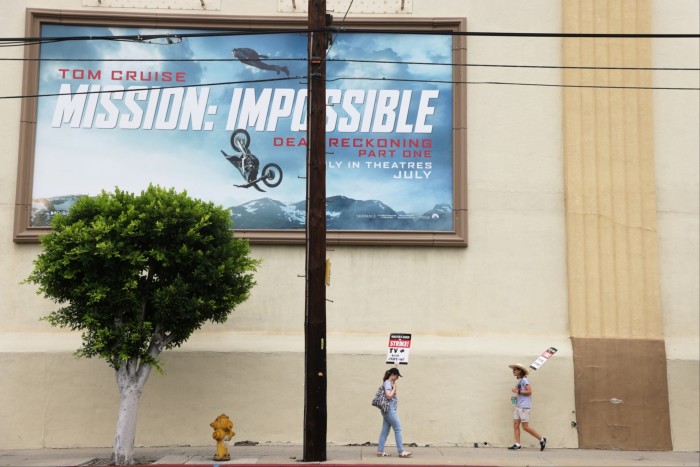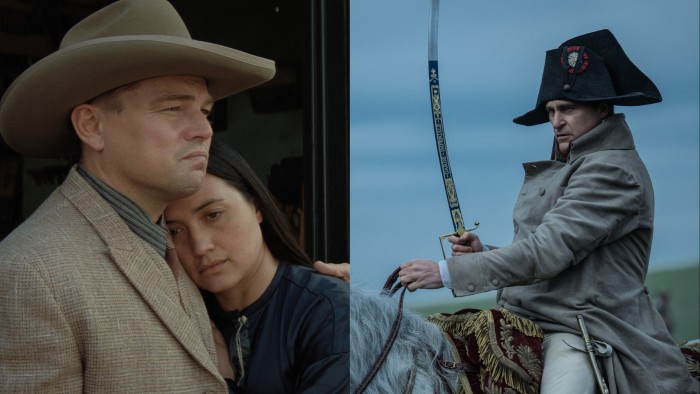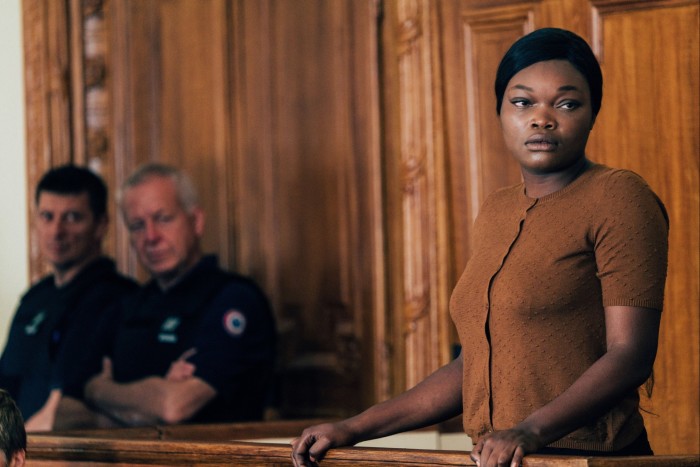So Barbie saved the day, while all around her went up in flames. An honest account of the year in film has to acknowledge the sense of crisis still gripping the industry, but also the triumph of Greta Gerwig’s hot pink comedy, which ends 2023 having made almost $1.5bn worldwide.
In the numbers game alone, that crowned Gerwig and star-producer Margot Robbie queens of the box office. But their movie also won the other prize most valued by the film business: a place of relevance at the very centre of the culture. It just took a lot of people filming themselves singing “I’m Just Ken”, then posting the results online.
That the film industry might now exist largely to provide material for TikTok is an uncomfortable thought. But then, in a year this turbulent, why would cinema be any less so? The secret of the movies’ place as history’s most productive marriage of art and commerce has always been mirroring the wider mood. So it’s only natural that the past 12 months would see Hollywood convulsed by economic strife — and unnerved by the future.
A case in point. With the coming US presidential election dogged by fears of gerontocracy, film too has mixed feelings about age and experience. Chief among the brand-name directors to release new work in 2023 was Martin Scorsese, now 81, with his historical true-crime drama Killers of the Flower Moon. Then came Napoleon, from the 86-year-old Ridley Scott. But cinema is at a strange junction, torn between venerating tribal elders and demanding new voices. Scorsese remains a sacred cow; Scott rather less so, with scorn heaped on his unruly portrait of the emperor.
And calling back to the past, typically such a safe commercial bet, also went awry. In 2022, nostalgia caused a box office crush for Top Gun: Maverick. This July, star Tom Cruise dusted off another old role in Mission: Impossible — Dead Reckoning Part One. Movie-goers everywhere quietly blocked his number.

Instead, the summer belonged to Barbie. Or, perhaps, to the marketing phenomenon that would come to be known as Barbenheimer. Right up until their dual release on July 21, the clash between Gerwig’s film and Christopher Nolan’s Oppenheimer was seen as a game of blockbuster chicken. (To add industry intrigue, Barbie was backed by Warner Bros, whose long relationship with Nolan ended badly; the director made Oppenheimer for Universal.)
Instead, the two movies found themselves entwined as an unlikely double-bill, expensive PR campaigns turbocharged by countless unpaid boosters on social media. In truth, there was always a touch of fantasy to the idea of the two movies as such comic opposites. After all, both were starry, skilful Hollywood entertainments. But the pitch worked. Barbie made $1.44bn; Oppenheimer $951mn.
In both cases, TikToks had to take the place of celebrity on the promotional trail. Ahead of Oppenheimer’s London premiere in July, Cillian Murphy and co-stars horseplayed on the red carpet. By the time Nolan introduced the film, the cast had vanished. In the interim, the Screen Actors Guild had begun its industry-wide strike. Actors of vast fame and none at all thus joined the Hollywood writers already taking similar action.
The writers struck for 148 days; the actors 118. It would be the largest-scale labour dispute in US film and television since 1960. Between packed cinemas and silent film sets, the lack of stars from the publicity circuit was a constant reminder of complaints about contracts, fees and AI. It also put the spotlight on a more general unease that an industry reshaped by Netflix had deepened the divide between its haves and have-nots.
The focus turned to Hollywood CEOs, including Disney’s Bob Iger and David Zaslav, pugnacious head of Warner Bros. The attention was not always flattering. (In an ironic sidebar, both studios celebrated 100th anniversaries this year.) Yet in time for Oscar season, a deal was finally brokered, seen to meet at least some of the talent’s key demands.
Only 2024 will begin to tell us if the strikes ended with real solutions for a troubled industry, or mere sticking plasters. And creatively we’ll learn if Barbenheimer was half-accidental lightning in a bottle — or the start of a whole new chapter.

The two issues are not unrelated. In the background to this year’s turmoil was an ever fiercer jostling among studios and streamers for audiences, at a point when their usual tools of spin-off and sequels seemed suddenly blunted. (In 2023, even Marvel and their multi-part sagas ran aground.) By contrast, Barbie and Oppenheimer were standalones, their success taken by optimists as a sign that Hollywood would now go all in on original stories. Maybe. When it comes to that particular bad habit, we should believe it when we don’t see it.
Outside a few big winners, box office was still patchy. More than that, it was opaque. Having spent a reported $200mn backing Scorsese’s Killers of the Flower Moon, only Apple knows how much relatively modest ticket sales even matter beside questions of branding and Apple TV+ subscriptions. The year ended, meanwhile, with the famously vague Netflix finally revealing viewing data for its first six months of the year. But the Godzilla spreadsheet the company released posed as many questions as it answered — the raw metric of “hours watched” a fuzzy measure for the impact of a film.
Amid the confusion, we were left to argue about what was actually any good. Even Netflix delivered the occasional doozy: Bradley Cooper’s kinetic Maestro among them. And in the year that tired of sequels, one of Hollywood’s best moments was the seventh film in a franchise: the strangest thing about the latest Mission: Impossible having flopped was what fine-tuned fun it was.
But European cinema offered the brightest spots of 2023, with two bracingly smart French courtroom dramas in Anatomy of a Fall and Saint Omer, Polish-Italian fable EO and knotted Spanish thriller The Beasts. Yet bad news lurked nearby. Soon after Hollywood returned to work last month, UK production body Pact reported that a threadbare British independent film sector is now at the point of market failure. The end credits beckon for the first home of Christopher Nolan.

Still, a vital sign is the ability to cause a stink. That much was duly achieved by a pair of pantomime villains: Napoleon and Emerald Fennell’s Saltburn. Some saw the former as a travesty. To others (me included), the latter was a grim dollop of snobbery. But, like Barbie, they both proved that, even now, nothing gets people talking like the movies. Like a fractious elderly relative causing havoc at a family Christmas, we shall miss them when they’re gone.












